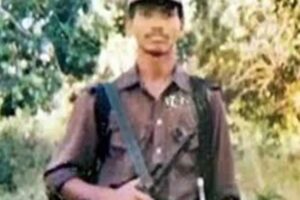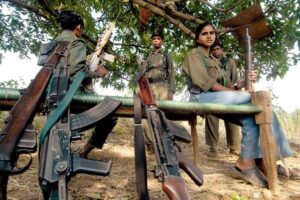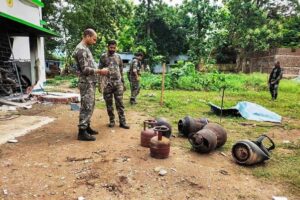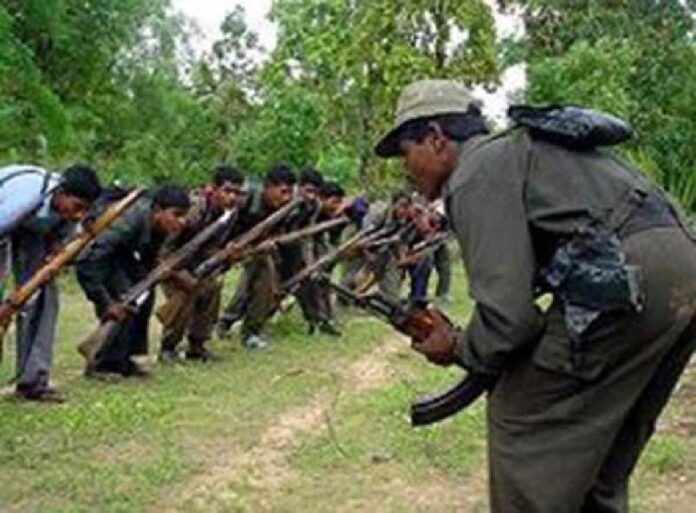The Madvi Hidma is the youngest member of the Central Committee of Communist Party of India (Maoist). Hidma is responsible for various attacks on the security forces in Chhattisgarh, and the 2013 Naxal attack in Darbha valley. A bounty has been placed for his capture.
 Hidma was born in Purvati village of south Sukma in the Indian state of Chhattisgarh. He is also known as Hidmalu alias Santosh and is the face of Maoist in Bastar. After completion of education up to class 10, he joined the Party and became a master strategist of military operation and guerrilla warfare.
Hidma was born in Purvati village of south Sukma in the Indian state of Chhattisgarh. He is also known as Hidmalu alias Santosh and is the face of Maoist in Bastar. After completion of education up to class 10, he joined the Party and became a master strategist of military operation and guerrilla warfare.
Hidma was arrested in 2016 along with six other alleged naxals, at the time he was considered a low-level participant. About that time, Hidma became the area commander of People’s Liberation Guerrilla Army Battalion No 1 and an active member of the Dandakaranya Special Zonal Committee of the CPI (Maoist), which operates in the Sukma, Dantewada and Bijapur areas. He was promoted to the Party’s Central Committee as the youngest member. It is believed that Hidma is one of the masterminds behind a number of fierce attacks on security personnel that took place about a decade ago, including the April 2010 Maoist attack in Dantewada and 2017 Sukma attack. All told he is cited as being responsible for twenty-six separate attacks. Indian Agencies have also declared a Rs.45 Lakh bounty on his head. Look at the faces of the resting Naxal fighters in the cover photograph above. What do you see? Weather-beaten, battle-scarred, lean and emotion-less faces, sensibilities deadened by survival tensions and battle fatigue. These are young people just past adolescence, fighting for a cause they believe in but with resigned fatalism etched into their personas betraying no hope or expectation they’ll survive for long, but damned if they are not going to give it their all before going down!
Look at the faces of the resting Naxal fighters in the cover photograph above. What do you see? Weather-beaten, battle-scarred, lean and emotion-less faces, sensibilities deadened by survival tensions and battle fatigue. These are young people just past adolescence, fighting for a cause they believe in but with resigned fatalism etched into their personas betraying no hope or expectation they’ll survive for long, but damned if they are not going to give it their all before going down!
It is such youth who followed Che Guevara and Fidel Castro into the Sierra Maestre mountains in Cuba before springing the revolution on Fulgencio Batista’s military junta in 1959, and were part of the anti-colonial force of the FLN (Front de Liberacion Nationale) seeking freedom for Algeria. They constituted the sharp edge of the Viet Cong, undertaking the most dangerous missions against US MACV (Military Assistance Command, Vietnam), and formed the most lethal element of Pirbhakaran’s Liberation Tigers of the Tamil Eelam (LTTE) that slam-banged the Sri Lankan military and almost singlehandedly drove the Indian “peace-keeping force” out of Sri Lanka.
 And it is the Naxals led by their young charismatic commander in the Pirbhakaran mould, Madvi Hidma — “Area commander, People’s Liberation Guerrilla Army, Battalion No 1, of the Dandakaranya Special Zonal Committee of the Communist Party of India (Maoist)”, who could be the reason for the new Spring for Naxalism in the country, set as he is to head the party’s Central Military Commission that oversees all guerilla activity against the Indian state.
And it is the Naxals led by their young charismatic commander in the Pirbhakaran mould, Madvi Hidma — “Area commander, People’s Liberation Guerrilla Army, Battalion No 1, of the Dandakaranya Special Zonal Committee of the Communist Party of India (Maoist)”, who could be the reason for the new Spring for Naxalism in the country, set as he is to head the party’s Central Military Commission that oversees all guerilla activity against the Indian state.
One thing the Indian government cannot allow to happen is for Hidma to grow his legend as Lord of the Red Corridor stretching from Andhra Pradesh, Maharashtra, Chhatisgarh, Jharkand, Bihar to the borders of Nepal — the route China uses to keep the Naxals amply supplied, besides support equipment like communications sets, satellite phones, and other paraphernalia, with Kalashnikovs and unlimited stock of ammo, needed to sustain a successful rebellion.
Indeed, his reputation grows in tandem with the bounty on him announced by the State, which has inreased from Rs 25 lakhs a few years ago to Rs 40 lakhs now. The trouble is this: As any guerilla war primer will tell you it is the growing legend of a fighting leader that, more than any other factor, drives an insurgency. Think Che’ in Bolivia!
Such a leader is the magnet drawing new recruits to the cause, an endless line of impressionable youngsters, and not just from the impoverished tribal hinterlands of Bastar, who have nothing to lose — here can’t get the words of Janis Joplin’s counter-cultural anthem from the Sixties out of my mind — ‘Freedom is just another word for nothin’ left to lose”!
It is to the jefe maximo’s standard that the young will rally until Hidma’s repeated successes ensure that if the Naxals cannot prevail over the Indian state, they cannot be defeated either.
The core problem is the ‘Special Forces’ sent to overcome this menace, who are special only in name. Look at the pic of SF troops at their ease, below:
 What do you see? Well shod and accoutred, well-armed, fairly content SF troopers, each with a hint and more of belly that comes from eating well, being looked after well. It can be safely surmised from one look at such SF (in real life and pics) that they are about as capable of prosecuting decisive anti-guerilla actions as a bunch of pot-bellied Delhi traffic cops parachuted into the Sukma forests (where Hidma cut his teeth) would be!
What do you see? Well shod and accoutred, well-armed, fairly content SF troopers, each with a hint and more of belly that comes from eating well, being looked after well. It can be safely surmised from one look at such SF (in real life and pics) that they are about as capable of prosecuting decisive anti-guerilla actions as a bunch of pot-bellied Delhi traffic cops parachuted into the Sukma forests (where Hidma cut his teeth) would be!
What’s the problem? Well, for one thing, Hidma’s strategic mindset and tactical nous.
But, let’s start with the immediate situation the government has at hand. Hidma ordered his outfit to wipe out a platoon plus of SF troops — 22 killed, 30-odd injured — an action on April 3 in the forested badlands around Bijapur in Chhatisgarh state that resulted in four of his own cadre dead.
This was a successful outing in terms of exchange ratio, especially considering the Naxals also augmented their arsenal by 14 SF weapons and 2000 rounds of ammo — not a small haul for the guerilla! But, mindful of the Indian state’s perennial weak spot, he also instructed his fighters to capture at least one SF trooper alive as bargaining card. Hence, SF Constable Rakeshwar Singh Minhas is now a Naxal prisoner. (He has been released now with the help of a team of journalists and activists).
The main unit featured in this debacle is Central Reserve Police Force’s COBRA (Commando Battalion for Resolute Action). Methinks, some wise guy in the Home Ministry in 2009 when the battalion was being raised, thought up this fearsome name and then configured an appropriate acronym around it!
 It only underscores the reality that no one in the Indian government (or, going by the record, even in the Indian military) quite understands what ‘commando’ actually means other than as an appelation for some armed unit or the other in spiffy black dungaree uniforms, purple berets, equipped with special weapons to acquire which some babu must have signed off on.
It only underscores the reality that no one in the Indian government (or, going by the record, even in the Indian military) quite understands what ‘commando’ actually means other than as an appelation for some armed unit or the other in spiffy black dungaree uniforms, purple berets, equipped with special weapons to acquire which some babu must have signed off on.
The word commando is of Boer War (1899-1902) origin where the British rulers in South Africa discovered that the Dutch Boers (settlers) they were fighting were making monkeys out of the British forces in the field by operating in self-sufficient small units (the Boer called commando), which were agile, struck fast and hard and then melted away, and left immensely disruptive/destructive outcomes in their wake.
Winston Churchill first used the word commando for the British Special Forces (Special Boat Service, Special Air Service, etc.) he established during the Second World War, which he hoped would function like the original Boer units. It is in this sense the word has since come into common usage.
So, who is Madvi Hidma and why does he terrorize the COBRA so?
Hidma, it turns out, has built his reputation on the backs of the COBRA kind of rank-incompetent SF tasked to deal with the Naxals.
(1) There’s by now ample evidence from all over the world of how effectively to neutralize guerillas.
(2) It requires a commando force that can operate in extremely small groups, living off the jungle, and entirely untethered from the logistics supply chain, in complete radio silence, armed with minimal weapons holdings — knives, and at most small arms with silencers and limited ammo for relatively soundless elimination of the guerilla opponent.
(3) The commando groups are best deployed in designated areas on the basis of as extensive as possible intel gathered from local informants and surveillance mechanisms and technical sensors, about the size of the guerilla force active in that grid area, about their kit, gender constitution of the group, their movement patterns, and the villages identified as sympathetic to the Naxals.
(4) Such commando groups should be out in the field for six months at a time, followed by 6 months off and conducting themselves in a non-splurgy manner with cover of decent jobs in distant cities that only allow for short home visits, etc. — precautions so as to not arouse curiosity among the local people.
In the field, they work incommunicado, and remorselessly to track and hunt down the guerillas following tell-tale signs (camp sites, cooking fires, etc) and execute them unarmed combat style or by knife, rarely using the silenced small arms for the kills, with the kill list prioritizing leaders and would-be leaders. Nothing is more demoralizing for the cadre than to have regular attrition in the leadership ranks.
Moreover, fighting and dealing with a foe who is just as mobile and fearless and with no set method in operations of warfare as themselves, is the most difficult thing for the guerillas to handle.
(5) The best commando are recruited from among the same local unmarried youth pool the guerillas hail from, and who are familiar with the terrain and the local lingo. Except they are given specialized training in SF camps far away from their areas of ops. And, most importantly, they are rewarded handsomely with hefty remuneration and should the operative die in action, it should be seen to it that a rich life insurance package reaches his/her family through indirect means, so the families — who are always kept in the dark about the dead trooper’s exact work — do not, in turn, become targets for vengeful Naxals.
The above is a bare sketch of how the entire anti-Naxal commando set-up ought ideally to function. Let’s briefly deconstruct this event from newspaper reports.
1. Intel is received by COBRA of a top Naxal leader, possibly Hidma, holed up in the vicinity of a triad of villages — Jonaguda, Jeeragaon and Tekalgudum, located in an elongated U with their backs, as it were, to the hills.
2. No effort is made to validate and verify the intel so received, which is difficult to do any way given that the villagers are more in simpatico with the Naxals than with the police and the paramils, and in any case are Mao’s water in which the guerilla fish swim.
3. A force of some 1,700 security personnel is mobilized for a combing operation of this entire area on April 2. There’s no encounter, they find nothing.
4. Unbenownst to the COBRA SF-led contingent, Hidma had in days previous both cleared the three villages of its residents to avoid needless loss of life of locals which caring and thoughtfulness, in the aftermath of incident, will have won him goodwill and confirmed his standing with the locals. And, he brought in some 350 Naxal fighters from the extended area for this operation, and hid them — how? There’s his genius.
5. This last activity — the movement of such a large number of Naxals converging on the 3-villages vicinity is not detected by any police or COBRA or any other intel agency — that’s how effective they are!
6. On April 3, some 450 personnel detached from the larger 1700-strong anti-terrorist group that combed that sub-sector the day before, and now presumably on a mission to capture or kill Hidma, proceed towards these villages, and walk la di-dah fashion with eyes wide open quite literally into Hidma’s trap.
7. How this fairly large SF contingent advancing in dispersed mode, entirely missed the armed Naxals hiding in the approaches to the villages suggests just how careless and unconcerned these paramil troops were sauntering in, and why they simply did not expect the surprise attack by the Naxal fighters, who began firing at them from the rear over ground they had just traversed even as they faced Naxal fire from the sides and the front.
8. Once the SF bulk force was well inside the cauldron, for the Naxals it was a free fire zone with raking AK-47 fire, or picking off of the paramil troopers in the middle individually.
9. Even as this fire duel was underway, Naxals began closing the wide open side of the U — the fourth side — to prevent the trapped police from escaping, using this entry-exit channel.
10. In the intense exchange of fire the COBRA-led SF had no chance; the ratio of the dead and injured on the two sides reflects it — 55 SF to 20 Naxals for an attrition rate of 2:1 disfavouring the SF.
The obvious conclusion is these COBRA and other groups, far from displaying any commando skills or specialized training, were remiss in not following even common sense rules when engaging with the enemy in known Naxal-infested territory. They did not do the obvious thing of carefully and thoroughly vetting the intel on Hidma, and then equally deliberately moving through the lightly forested jungle landscape towards the villages, which action — had it been diligently carried out — would have ended up revealing the hidden Naxals which, in turn, might have sparked firefights but on a far smaller scale, with next to nil SF dead or casualties if the first ragged SF line advancing towards Jeeragaon had done their job professionally.Instead, confident that Hidma and his cohort were unaware of the fate awaiting them, the paramils advanced without sanitizing the approaches.
The reason no state police or paramilitary organizations have a genuine commando is because nobody wants the onerous job of living off the land and tracking and hunting down the Naxals. Most paramil SF on anti-Naxal duty have to have their hot rations — daal-chawal fetched to them by a long and conspicuous logistics line, which also arranges vehicles to carry them in trucks to the edge of the jungle for them too disembark and fight.
Such police forces are thus tied to the roads, leaving the rest of the countryside without proper connectivity as the domain for the Naxals to put down roots, indoctrinate the local people, and create a sympathetic and supportive milieu for them to operate in.
So while the Naxals are kept well informed by the grateful local people about police movements and other relevant developments on their home ground, the grid for their potential ops is totally terra incognita to the SF troops armed with spotty intel when not fed straightforward misinformation as a lure in this instance.
It is also true that most of the troops selected for SF do not meet particularly rigorous standards and because they are mostly married men having children, are risk averse in extremis, and simply do not want to court any danger.
This is in sync with, and reinforced by, the risk-minimizing mindset of the top paramil leadership, which does not care to reside in the countryside or to lead from the front. This is because the top paramil ranks are exclusively officered, not by the force’s own officer cadre, but by officers on rotation from the Indian Police Service, most of whom acquire minimal policing skills and competence on the job over the years that are not always of high quality. Most such IPS officers, moreover, do not have their heart in the hard and dangerous job of fighting Naxals. In any case, they are not hands-on managers of the counter-insurgency effort needed to make successes out of the anti-Naxal campaigns.
An example of a truly effective anti-insurgency commando are the units France fielded in Algeria in 1958-59 — the ‘commandos de chasse’ (hunting commando) with Algerian Arabs comprising some 60% of this force, who were so ruthless and bloodyminded in their actions, especially in the Arab quarter of Algiers — the casbah — that their killing sprees caused enough popular revulsion in France to compel President Charles de Gaulle to announce Algeria’s freedom.
No Indian commando unit can ever function or be anywhere as effective and efficient in eliminating the Naxal threat as the French commando in Algeria were when tackling the FLN. But there has to be that level of intent and commitment to find from among the tribal people in the red corridor — like the Kuka Parey group of Valley Muslims the state funded in Jammu & Kashmir 20 years ago, whose members were the perfect foil for the cross-border jehadis — who believe in India enough to fight for it.
Absent such option, Naxalism will wax and wane but the Indian state will continue to fail to stamp it out. And Naxals will be the news fodder on the days they achieve spectacular success or, more routinely, when they blow up a culvert here or a transport carrying police with expertly engineered IEDs (improvized explosion devices) there, or when these police — innocents in Naxal-land — step on expertly placed mines on jungle paths, and get blown up.
To divert the attention of the public from their continuing failure to tackle Naxalism, the senior police leaders occasionally deploy helicopters borrowed from the air force to drop their “commando” in some wretched jungle clearing or the other, where the troopers will shoot up some trees and make a show of force, even as the no doubt amused Naxals — invisible to these police, watch on, itching to fire on the easy targets that the whirlybirds offer, and whose use only ends up directing the Naxals to the area where their vulnerable targets have dismounted and can be found!
What the government and the forces fighting the Naxal threat have to bear in mind and reconcile to is this reality that the young, recklessly bold, and highly motivated Naxal fighters are the only true commando in the field; and that subduing them is beyond the ken of the spurious commando proliferating in the state and central police. #KhabarLive #hydnews







